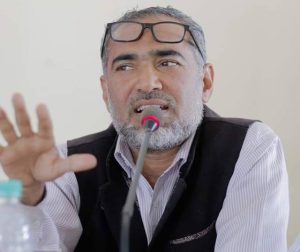
The educational backwardness of Muslims emerged as one of the most important problems of the Muslim community after India gained Independence, and continues to remain so. It is multifaceted. An important aspect of this problem is lack of moral education. In independent India, the Muslim community has assumed moral education to imply religious education.
After the French Revolution, secularism was promoted and religion excluded from the field of education at the global level. Religious education became the responsibility of religious institutions and government schools became custodians of secular education. Before the Industrial Revolution, skills were the means of livelihood, but later secular education became the main prerequisite and requirement for earning one’s livelihood.
The Renaissance led educated skilled workers to acquire great importance in factories. Education along with skills proved to be the impetus for research and development. The economic domain was dominated by machines, factories, workers, and long working hours.
Today, economy is in the hands of intellectuals, creative and analytical minds, rather than those with just technical skills. Education serves economy almost like a slave and in its servitude, education has abandoned all morals and virtues. As morality and character building were excluded from education, man was reduced to a beast of burden and a mere tool for maximising production. He led the surge in economic development but suffered socially from dismay and disappointment. He started losing human characteristics like social contact, companionship, marital bliss, sympathy, empathy, respect for congenital relations, mercy, and a feeling of accountability, etc. These human characteristics are called morals in religion and are termed social skills in the secular way of life.
There is a fundamental difference between morals and social skills. The source of morality is monotheism and social skills emanate from materialism and love for the world. The former is for the sake of God, while the latter satisfy cravings of the heart and consummation of lust. The people that society needs can be developed through moral education while those prepared through training in social skills find their calling in the corporate world. If a person’s morals are limited to selfishness, self-interest and worldly pursuit, they are known as social skills in modern terminology. However, when these morals move beyond this frame and enter the realm of conformation to divinely ordained moral limits, they become associated with what is termed as “virtues”.
The source of virtues is divine revelation and emulating the character of Prophet Muhammad ﷺ. The creation of virtues and good morals is the mission of all human endeavours. This process is called tazkiya (purification). Purification is not just turning the beads of a rosary, but the building of people who imbibe high morals, abide by the divinely ordained moral limits and build their personality becoming ideals for others to emulate. Their lives should be like that of a honeybee, consuming clean food and giving benefits to society.
After this brief explanation, it becomes apparent that the emphasis of the Islamic education system is on developing morals and virtues and not social skills. This was the mission of all the Prophets and that of Prophet Muhammad ﷺ. The Muslim community in India has been emphasising moral education. It has been trying its best to provide religious education along with secular education. While sincere efforts have been made to cater to this ardent desire of the Muslim community by many educational institutions, some commercial educational institutions are exploiting this religious fervour, zeal and demand for the simultaneous provision of both religious and secular education. Nowadays, many educational institutes are advertising themselves by using captions that qualify their institute as “the beautiful combination of religious and secular education”. Such advertisements also have a picture of an adorable child. In the image used in such advertisements, the child is seen holding a copy of the Qur’ān in one hand, a pen in the other and a stethoscope hanging around his/her neck. The approach to religious and moral education is the same for both systems, be it the system of religious education only or the educational system, which is the combination of both religious and secular education.
INDIAN EDUCATION SYSTEM AND MORAL EDUCATION
The history of education in India begins with the Vedic era, which is considered as old as 4000 BC. In ancient times, the Buddhists made great strides in the field of education. The residences of Buddhist scholars were called ‘Viharas’. Every ‘Vihara’ used to be an educational centre as well. There was a lot of strife and friction between the Brahmins and the Buddhists over imparting education. “Brahminism” ascribes knowledge as the exclusive dominion of the Brahmin community. Brahmins considered the universality of knowledge to be an attack on the caste system, while the Buddhists took pleasure in imparting knowledge to the masses. The University of Nalanda in ancient India was founded by Buddhists who were against the caste system and Brahmanism. Whether it was the Buddhist viharas or Brahmin ashrams, religious and spiritual education was central to these centres of learning.
Even during the Mughal period, religious education was accorded primary importance, but other subjects including medicine and other skills also began being taught. During the Mughal period, apart from the need for religious scholars, individuals were required for court work, administration, collection of taxes, healthcare and the judiciary. The Mughals arranged to cater to the above demand. The network of schools was quite extensive during the Mughal period. Grants (aid) were given to schools, madrasas and even ashrams belonging to the Hindu faith. There was a similar system in the regions where the Mughal rule was not prevalent and some other ruling dynasty was in power.
The British made changes in the name of reforms and reorganisation in the education sector. The promotion of the English language was the top priority for the British in the field of education. The Macaulay Committee was formed to review the system of education in India and suggest suitable reforms. T.B. Macaulay presented his report on 2 February 1835. The proposals presented in this report were given legal status in the same year and the English Education Act 1835 was passed. Due to this law, English was given priority over Arabic, Persian and Sanskrit. Government aid to madrassas was reduced. The British government withdrew itself from supporting religious education.
The country gained independence in 1947. But even today the influence of Macaulay’s model remains intact. Since independence, there have been some serious and casual attempts to liberate the education policy from the influence of Macaulay. Since Macaulay’s educational system was accepted in most parts of the world and the people needed to run the country could be prepared only with this system, therefore instead of trying to bring about fundamental changes in the Macaulay system, discussion began about including ethics in this system.
After independence, India became a constitutional democracy. Respect for all religions was incorporated in the Constitution of India and the freedom to practise and propagate one’s religion was included in the constitutional rights. The word secularism was added to the Constitution in 1976 through the 42nd Amendment of the Constitution. Therefore, after 1976, there was no more scope for officially imparting religious education in the country. However, the introduction of religions, the history of religions and information about religious leaders was included in the curriculum.
It is a different issue that their inclusion has been done inappropriately and in some official textbooks, lies and myths are perpetuated, while in some lessons, religions, especially Islam, and Muslim culture have been distorted and presented in a denigrating manner. After the inclusion of the word secularism in our Constitution and even before that (1976), India’s education system has been significantly less secular compared to other secular countries.
The political outfit of the right-wing forces in India managed to take over the reins of the central government nearly 70 years after India’s independence. However, the RSS and its sub-organisation Vidya Bharati, which stands for Vidya Bharati Akhil Bharati Shiksha Sansthan, have been active in the field of education since 1952. The national body of the Sansthan was formally established in 1977.
According to the Vidya Bharati website, “Some committed and patriotic people, who considered education an artifice to educate the young generation according to Indian values and culture started the first school in Gorakhpur, UP, in 1952. They named this school Saraswati Shishu Mandir-Temple of the Goddess Saraswati dedicated to children. Thanks to their zeal, dedication, and hard work similar schools began to be established in other places also. The number of such schools increased rapidly in Uttar Pradesh.
“A state-level Shishu Shiksha Prabandh Samiti was formed in 1958 for their proper guidance and planned development. Good education and sound sanskaras at the Saraswati Shishu Mandirs earned recognition, honour, and popularity in the society. Shishu Mandirs started spreading in other states and within a few years, many schools were established.”
Today the Vidya Bharati runs one of the largest private networks of schools in India, operating 12,000 schools with over 32 lakh students. (to be continued)
[The writer is Director, Markazi Taleemi Board, Jamaat-e-Islami Hind. He may be contacted at tanveer64@gmail.com]




